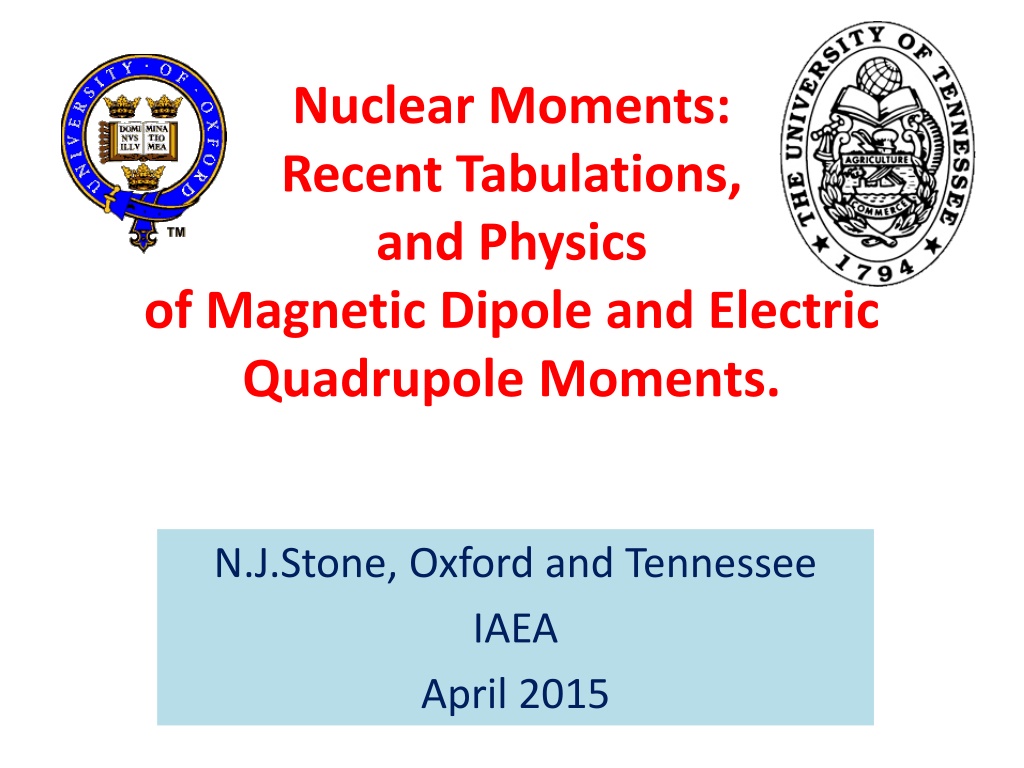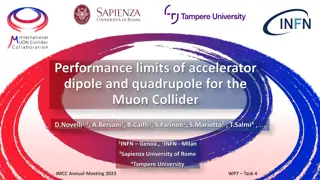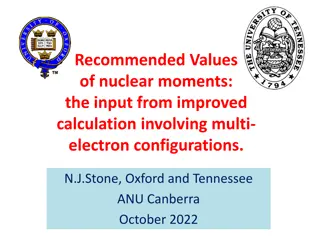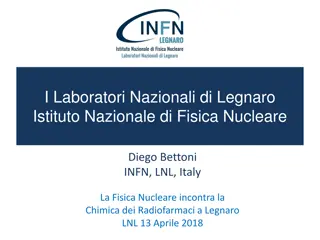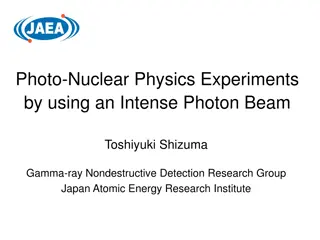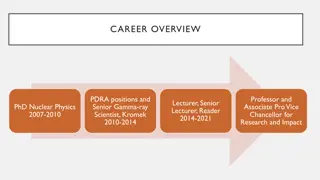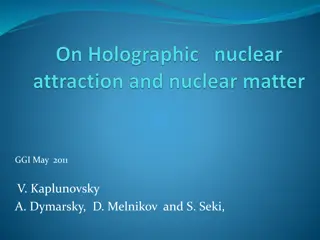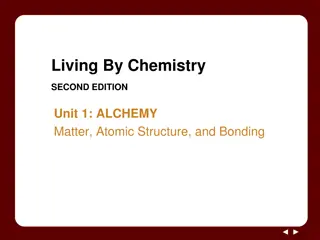Recent Advances in Nuclear Quadrupole Moments and Their Significance in Physics
This content discusses recent tabulations and physics of magnetic dipole and electric quadrupole moments in nuclear physics. The importance of seeking accurate determinations of nuclear quadrupole moments is highlighted, along with details on recommended values, statistics, and the significance of electric quadrupole moments in various fields of study. The role of electric field gradients, computational advancements, and the work of Pekka Pyykko in ensuring consistency in extracted moments are also explained.
Download Presentation

Please find below an Image/Link to download the presentation.
The content on the website is provided AS IS for your information and personal use only. It may not be sold, licensed, or shared on other websites without obtaining consent from the author. Download presentation by click this link. If you encounter any issues during the download, it is possible that the publisher has removed the file from their server.
E N D
Presentation Transcript
Nuclear Moments: Recent Tabulations, and Physics of Magnetic Dipole and Electric Quadrupole Moments. N.J.Stone, Oxford and Tennessee IAEA April 2015
Outline 1. Table of Recommended Nuclear Electric Quadrupole Moments Published IAEA 2013 [2. Compilation of Nuclear Magnetic Dipole and Electric Quadrupole Moments Published IAEA 2014, updated 2015] 3. Thoughts re preparation of Table of Recommended Nuclear Magnetic Dipole Moments
Table was published by the Nuclear data Section , IAEA Vienna, December 2013.
Motivation: Electric quadrupole moments Why do we need to seek the best possible determinations of nuclear quadrupole moments? For themselves: the electric quadrupole moment Q is an important measureable input for nuclear modelling. Oblate Prolate As a component of the electric quadrupole interaction in atoms, molecules, solids and liquids for analysis of electronic properties: measurement of electric field gradient and its symmetry has wide application in physics, chemistry and biology. Concerns relatively few isotopes, but it is important that their moments be determined accurately in order to obtain well measured electronic properties these cannot be determined to accuracy greater than that of the nuclear quadrupole moment concerned.
Some statistics: The table contains 1055 measured quadrupole moments of nuclei of 95 elements between hydrogen and einsteinium (Z = 99) Of these 642 are either stable or radioactive ground states or long-lived isomers 413 are short lived excited states No measurements for: He and the trans lead elements Cm, Bk and Cf. Latest entries: mid 2013 There are adopted standard efgs for 83 elements Those without adopted standards are; Si, P, Ar, Ag, Cd, Te, Ce, Tm, W, Pt, Po, At.
New Table of Recommended Values of Electric Quadrupole Moments What is measured? Nuclear quadrupole moment coupled with electric field gradient [efg] Unlike magnetic moment studies where an applied magnetic field can supplement an internal field, adequate laboratory produced efg s are not available. Efgs are (almost always) calculated not measured (exceptions Coulomb excitation, electron scattering ..) For many elements, since the first measurements, differing estimates of the efg in the same system and/or efg estimates in different systems have been used to extract nuclear moments from the electric quadrupole interaction strength Advances in computational ability in making high precision calculations in multi- electron systems, atoms, ions and compounds, yield ever more reliable values of electric field gradients acting at nuclei. The work of Pekka Pyykko needed to be applied to all quadrupole moment determinations to ensure consistency in extracted moments. Ref. Pyykko, Molecular Physics 99 1617 (2001) and 106 1965 (2008).
Estimates of error Often not limited by experiment Being based on computational methods, estimation of uncertainty is not straightforward. Authors often offer estimates of uncertainty. One check is the degree of agreement between independent calculations but remember the old saying .. Examples of good agreement and of discrepancies : -
Agreements and divergences Variation in best ground state Q moment values from different types of measurement and analysis. Where two isotopes are indicated the entry is their moment ratio. ________________________________________________________________________________ Isotope atomic molecular solid state mesonic variation (%) 23Na 35Cl 69Ga 79Br 85,87Rb 115In 127I 175Lu 197Au _________________________________________________________________________ 0.104(1) -0.0817(8) 0.174(3) 0.302(5) 0.48050(16) 0.48383(2) 0.772(5) 0.770(8) -0.680(10) 0.521(7) 0.104(1) 0.0850(11) 0.722(21) 0.560(30) +3.49(2) 0.0(10) 4.0(16) 1.8(22) 3.6(19) 0.69(3) 0.3(6) 6.2(30) 2.2(11) 9.8(54) 0.171(2) 0.313(3) 3.415(34) 0.510(15) Atomic - molecular agree Na, Ga, In differ Br, Rb, Au Atomic - solid state differ Cl, I, (Au) Atomic - mesonic differ Lu Conclusion: quadrupole moments accurate to ~ 1% at best.
Changes and problem elements All Table entries have been adjusted to the adopted standards wherever necessary. Often these changes are very minor, but in some cases they are not: 1. Values 2. Uncertainties 3. Problems
1. Values. Elements for which new efgs have produced considerable change in the extracted quadrupole moments as compared to most recent previous listing [N.J.S. IAEA 2011] . ______________________________________________________________________ Element Change from 2011 listing (%) F Ca Ge Se Sr In Sn Sb Cs Ba Gd ______________________________________________________________________ -22 -26.1 +15.3 -30.9 -7.6 -5.1 +25.7 +52 -6.0 +9.6 -5.0
2. Uncertainties Elements for which recent improved efg calculations have reduced uncertainties by a substantial factor. _____________________________________________________________________ Element Error reduction factor Element C 0.10 (i.e x 10) Sr F 0.25 In Ge 0.03 Sn Se 0.14 _____________________________________________________________________ Error reduction factor 0.10 0.4 0.7 Exception to minimum uncertainty The quadrupole moment of the deuteron has been recently recalculated using new methods to estimate the efg in HD and D2 molecules, the result Q (2H) = +0.0028578(3) compared to the previous best +0.00286(2) claims accuracy of 0.01% and uncertainty reduced by a factor of 50. Ref M. Pavanello et al., Phys Rev A 81 042526 (2010) .
3. Elements for which adopted efg inaccuracy causes large (>9%) quadruple moment uncertainty. ______________________________________________________________________ Element Error (%) in best efg value V 20 Cr 33 Zn 10 Ac Nd 10 Th Pm 27 Es ______________________________________________________________________ Element Error (%) in best efg value Sm Rn 10 10 12 21 12 Recall also Elements without adopted standards are; Si, P, Ar, Ag, Cd, Te, Ce, Tm, W, Pt, Po, At. All of which have some problems or conflicts and would benefit from detailed theoretical effort.
Conclusions Determination of nuclear electric quadrupole moments is a changing scene in which recent developments in multi-electron computation capability is producing major improvements in the quality of our knowledge. The new table aims to be a timely gathering of all published moment values brought up-to-date with the best computational efg results available, thus enabling: Nuclear theory to access accurately what we know about nuclear quadrupole moments. Other sciences using nuclear quadrupole interactions to make the best use of measurements of quadrupole interactions in an ever widening range of applications.
Magnetic dipole moments Motivation Nuclear structure sensitive tests of single particle composition of nuclear state wave-functions Schmidt limits, nuclear medium effects, meson exchange currents, configuration mixing Collective contributions to magnetism collective rotational g-factor Applications NMR widely used proton resonance, few stable nuclei Theory Fundamental questions re e.g. QED require well measured nuclear dipole moments to enable true tests of predicted vacuum polarisation and radiative corrections.
Uses of nuclear dipole moments Although certain nuclear dipole moments have great significance and require extremely precise measurement to deliver their optimal theoretical usefulness, the great majority have more humble application. In QCD tests heavy nuclei, ions with single electron high E and B fields mean self energy and radiative corrections to HFS attain 1% levels For nuclear physics modelling measurement of the dipole moment of a state gives detailed information concerning the make-up of the wave-function. It is thus a very informative data element which complements energy, spin and parity The magnetic moment determines: The primary single particle component of the wave-function and The degree of admixture of other significant configurations which can involve other single particle states of states coupled to collective excitations. Applications: NMR in many technologies including non-invasive imaging, microscopy Magnetic field measurement etc etc
Methodology of Measurement. Moment values obtained by ratio with known moment which is used to establish an applied magnetic field Proton moment: cyclotron resonance frequency to Larmor frequency in the same field to obtain g(p)/2. Penning trap Mooser et al. Nature 509 13388 (2014) measured ratio of For the 98 elements having at least one measured moment, the best measurement for the element gave reference to: All reference isotopes have moment errors < 1 in 10^6 the proton moment the deuteron moment 11B 14N 17O 19F 23Na 35,37Cl 39K 45Sc 129Xe 137Ba 12 31 1 2 1 1 6 2 1 1 1 1 Most precise is the proton: 3 in 10^9 (Others not recorded)
Magnetic dipole moments some basic statistics Recent tabulation [Stone, IAEA Nuclear Data Section Report (2014)] contains results on ~2200 magnetic moments of nuclear states. longer lived : Laser Resonant spectroscopy NMR on LT oriented nuclei Atomic beam resonance Conventional NMR (stable isotopes) Integral NO Mossbauer Effect Optical Pumping 547 143 106 103 56 54 32 shorter lived: TDPAC/TDPAD Integral PAC 446 218 Less than 10^-8 s Transient Field Recoil in Vacuum 393 46
Corrections to raw experimental data Methods fall into three groups, 1. Those in which the magnetic field is essentially an applied, external field. Here the field can be accurately controlled and measured. The first correction is for diamagnetism, which can be complex . Calculations by Feioch and Johnson give estimates for atoms. Correction depends upon details of chemical environment. Not generally available to high precision (< 0.01%). This correction is usually applied to NMR and -NMR results which have narrow absorption lines and resolution of order 1 in 10^5 or better. 2. Those which utilise internal fields generated by electrons in the sample. For these the origin of the field is important. The presence of a significant s- electron, Fermi contact, contribution means that the interaction is subject to both hyperfine anomaly (which depends upon the distribution of spin and orbital contributions to the nuclear moment) and also a nuclear charge radius correction which determines the variation of the electron wavefunction over the nucleus. Both can reach magnitudes of 1 2 % in high Z nuclei, occasionally larger, and are not amenable to precision calculation. Usually ingnored.
3. Those which use transient fields experienced by ions moving through magnetic material (the TF method) which is the mainstay of measurements for levels of lifetime < 10^8 s. These use empirical calibration empirical calibration varies between groups (Chalk River, Rutgers, Bonn, etc. Error estimates problematic. There is a clear need to rationalise this situation and to adopt an agreed form of calibration to generate a self-consistent set of results with reasonably assessed uncertainty.
Methods, errors and corrections group typical error largest uncer. poss corr applied usually size NMR 1 < 10^-5 dia dia yes 0.1 2 % B-NMR 1 < 10^-4 dia/resol dia yes 0.1 2 % Atom beam 2 ~ 10^-3 resol A, B terms hf anom no hf anom 0.1 . % Laser Methods 2 ~ 10^-3 resol A,B terms hf anom no hf anom 0.1 . % NMR/ON 2 ~ 10^-2 Bhf, Q int hf anom no Q unres. 0.1 % TF Comment: 3 ~ 10^-1 Calibration problems need attention Corrections are attempted when they are required, but not in great detail. Driven by difficulty and by limitation of nuclear theory interpretation.
Acknowledgement of assistance with table preparation Pekka Pyykko for advice and consultation re Q s. Joann Totans Boris Pritychenko Jagdish Tuli NNDC, Brookhaven for help in location of many older and obscure papers. Daniel Abriola IAEA Vienna, Nuclear Data Section for financial support.
Nuclear electric quadrupole moments and magnetic dipole moments form an active field of research, having multiple aspects and applications in nuclear physics and beyond. Thank you!
